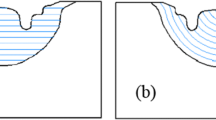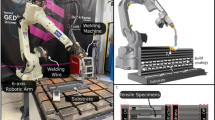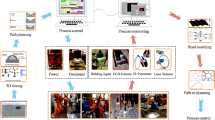Abstract
The surface of the hot forging die is prone to failure due to severe high heat and cyclical load during service. The remanufacturing of a forging die by wire and arc additive manufacturing technology could greatly improve the performance of the die and prolong its service life. In this paper, the remanufactured zone of the die was divided into three additive deposition layers with gradient mechanical properties based on temperature and stress analysis, namely, the transition layer, intermediate layer and strengthen layer, according to the thermal and stress conditions. A wire and arc additive manufacturing experiment with gradient material was conducted on 5CrNiMo hot forging die steel. The microstructure and mechanical properties of the gradient additive layer were characterized and analyzed. The results indicated that the microstructure of the gradient additive layer presents a transformation process of bainite-to-martensite from bottom to top. The hardness and strength of the transition layer, intermediate layer and strengthen layer exhibit a rational gradient increasing trend, while the impact toughness shows a decreasing trend. The wear loss and cumulative friction dissipated energy of the strengthen layer are considerably lower than those of the other layers. The mechanical properties of the gradient additive layer are shown as a gradient increase in hardness, strength, and wear resistance at high temperature, which is conducive to enhancing the overall pressure bearing capacity and preventing the failure of plastic deformation on the surface of the remanufactured hot forging die.























Similar content being viewed by others
Data Availability
The data sets supporting the results of this article are presented within the article itself.
Code Availability
Not applicable.
References
M. Hawryluk and J. Jakubik, Analysis of Forging Defects for Selected Industrial Die Forging Processes, Eng. Fail Anal., 2016, 59, p 396–409. https://doi.org/10.1016/j.engfailanal.2015.11.008
S. Chander and V. Chawla, Failure of Hot Forging Dies-An Updated Perspective, Mater. Today Proc., 2017, 4(2), p 1147–1157.
A.A. Emamverdia, Y. Sun, C. Cao, C. Pruncu, and Y. Wang, Current Failure Mechanisms and Treatment Methods of Hot Forging Tools (Dies)-a Review, Eng. Fail Anal., 2021, 129, p 105678.
Z. Gronostajski, M. Kaszuba, M. Hawryluk, and M. Zwierzchowski, A Review of the Degradation Mechanisms of the Hot Forging Tools, Arch. Civ. Mech. Eng., 2014, 14(4), p 528–539. https://doi.org/10.1016/j.acme.2014.07.002
C. Chen, Y. Wang, H. Ou, Y. He, and X. Tang, A Review on Remanufacture of Dies and Moulds, J. Clean. Prod., 2014, 64, p 13–23.
Z. Hu, X. Qin, and T. Shao, Welding Thermal Simulation and Metallurgical Characteristics Analysis in WAAM for 5CrNiMo Hot Forging Die Remanufacturing, Procedia Eng., 2017, 207, p 2203–2208.
Y. Shen, Y. Wei, Z. Li, X. Du, and S. Liu, Wire and Arc Additive Remanufacturing of Hot-Forging Dies: A Preliminary Study, Welding in the World, 2022, 66(8), p 1691–1702.
D. Ding, Z. Pan, D. Cuiuri, and H. Li, Wire-Feed Additive Manufacturing of Metal Components: Technologies, Developments and Future Interests, Int. J. Adv. Manuf. Technol., 2015, 81(1), p 465–481.
S. Lu, J. Zhou, and J. Zhang, Optimization of Welding Thickness on Casting-Steel Surface for Production of Forging Die, Int. J. Adv. Manuf. Technol., 2015, 76(5–8), p 1411–1419.
A. Voropaev, R. Korsmik, and I. Tsibulskiy, Features of Filler Wire Melting and Transferring in Wire-Arc Additive Manufacturing of Metal Workpieces, Materials, 2021, 14(17), p 5077.
T.A. Rodrigues, V. Duarte, R.M. Miranda, T.G. Santos, and J.P.Oliveira, Current Status and Perspectives on Wire and Arc Additive Manufacturing (WAAM), Materials, 2019, 12(7), p 1121.
L. Shen, J. Zhou, X. Ma, X.Z. Lu, J.W. Tu, X. Shang, F. Gao, and J.S. Zhang, Microstructure and Mechanical Properties of Hot Forging Die Manufactured by Bimetal-Layer Surfacing Technology, J. Mater. Process. Technol., 2017, 239, p 147–159.
P. Widomski and Z. Gronostajski, Comprehensive Review of Methods for Increasing the Durability of Hot Forging Tools, Procedia Manuf., 2020, 47, p 349–355.
X.J. Liu, H.C. Wang, and D.W. Li, Study on Design Techniques of a Long Life Hot Forging Die With Multi-Materials, Acta Metall. Sinica (English Lett.), 2007, 20(6), p 448–456.
J. Zhang, J. Zhou, Y. Tao, L. Shen, and M. Li, The Microstructure and Properties Change of Dies Manufactured by Bimetal-Gradient-Layer Surfacing Technology, Int. J. Adv. Manuf. Technol., 2015, 80(9–12), p 1807–1814.
H.J. Wang, Y.Z. Wu, H.C. Wang, Y.Z. Sun, and G. Wang, Design Method and Verification for Long Life Hot Forging Die, Mater. Res. Innovations, 2011, 15(sup1), p s377–s380.
C. Deng, X. Wang, Y. Yu Regions Division and Material Selection of Hot Forging Molds Based on Design of Equal Life. Ordnance Mater. Sci. Eng. 2, 12–14,15 (2015)
X. Hong, G. Xiao, Y. Zhang, and J. Zhou, Research on Gradient Additive Remanufacturing of Ultra-Large Hot Forging Die Based on Automatic Wire Arc Additive Manufacturing Technology, Int. J. Adv. Manuf. Technol., 2021, 116(7), p 2243–2254.
A.R. McAndrew, M.A. Rosales, P.A. Colegrove, Interpass Rolling of Ti-6Al-4V Wire+Arc Additively Manufactured Features for Microstructural Refinement, Addit. Manuf., 2018, 21, p 340–349.
X. Xu, S. Ganguly, J. Ding, C.E. Seow, and S. Williams, Enhancing Mechanical Properties of Wire+Arc Additively Manufactured Inconel 718 Superalloy Through In-Process Thermomechanical Processing, Mater. Des., 2018, 160, p 1042–1051.
J.L. Gu, J.L. Ding, B.Q. Cong, J. Bai, H.M. Gu, S.W. Williams, and Y.C. Zhai, The Influence of Wire Properties on the Quality and Performance of Wire+Arc Additive Manufactured Aluminium Parts, Adv. Mater. Res., 2014, 1081, p 210–214.
J. Guo, Y. Zhou, C. Liu, Q. Wu, X. Chen, and J. Lu, Wire Arc Additive Manufacturing of AZ31 Magnesium Alloy: Grain Refinement by Adjusting Pulse Frequency, Materials, 2016, 9, p 823.
C.V. Haden, G. Zeng, F.M. Carter III, C. Ruhl, B.A. Krick, and D.G. Harlow, Wire and Arc Additive Manufactured Steel: Tensile and Wear Properties, Addit. Manuf., 2017, 16, p 115–123.
W. Wu, J. Xue, L. Wang, Z. Zhang, Y. Hu, and C. Dong, Forming Process, Microstructure, and Mechanical Properties of Thin-Walled 316L Stainless Steel Using Speed-Cold-Welding Additive Manufacturing, Metals, 2019, 9(1), p 109.
J. Zhang, J. Zhou, Q. Wang, G. Xiao, and G. Quan, Process Planning of Automatic Wire Arc Additive Remanufacturing For Hot Forging Die, Int. J. Adv. Manuf. Technol., 2020, 109(5–6), p 1613–1623.
Z. Hu, L. Hua, X. Qin, M. Ni, Z. Liu, and C. Liang, Region-Based Path Planning Method with All Horizontal Welding Position for Robotic Curved Layer Wire and Arc Additive Manufacturing, Robot. Comput. Integrated Manuf., 2022, 74, p 102286.
Y. Shen, Y. Wei, and R. Liu, A Path Generation Method for Wire and Arc Additive Remanufacturing of Complex Hot Forging Dies, Int. J. Adv. Manuf. Technol., 2021, 117(5), p 1935–1943.
Y. Ali, P. Henckell, J. Hildebrand, J. Reimann, J.P. Bergmann, and S. Barnikol-Oettler, Wire Arc Additive Manufacturing of Hot Work Tool Steel with CMT Process, J. Mater. Process. Technol., 2019, 269, p 109–116.
Z. Hu, X. Qin, Y. Li, and M. Ni, Welding Parameters Prediction for Arbitrary Layer Height in Robotic Wire and Arc Additive Manufacturing, J. Mech. Sci. Technol., 2020, 34(4), p 1683–1695.
M. Ni, X. Qin, Z. Hu, F. Ji, S. Yang, and S. Wang, Forming Characteristics and Control Method of Weld Bead for GMAW on Curved Surface, Int. J. Adv. Manuf. Technol., 2022, 119(3), p 1883–1908.
M. Amin, L. Ali The Role of Weld-Deposited Working Layer on the Performance of Hot Forging Dies. Pakistan J. Eng. Appl. Sci. (2013)
T. Wang, Y. Zhang, Z. Wu, and C. Shi, Microstructure and Properties of Die Steel Fabricated by WAAM Using H13 Wire, Vacuum, 2018, 149, p 185–189.
A.N.M. Tanvir, M.R. Ahsan, G. Seo, B. Bates, C. Lee, P.K. Liaw, M. Noakes, A. Nycz, C. Ji, and D.B. Kim, Phase Stability and Mechanical Properties of Wire+Arc Additively Manufactured H13 Tool Steel at Elevated Temperatures, J. Mater. Sci. Technol., 2021, 67, p 80–94.
S. Uzonyi, Application of Additive Manufacturing for the Repair of Forging Dies, Acta Materialia Transylvanica, 2019, 2(2), p 121–125.
L. Shen, J. Zhou, Y.B. Xiong, J.S. Zhang, and Y. Meng, Analysis of Service Condition of Large Hot Forging Die and Refabrication of Die By Bimetal-Layer Weld Surfacing Technology with a Cobalt-Based Superalloy and a Ferrous Alloy, J. Manuf. Process., 2018, 31, p 731–743.
S. Peng, J. Zhou, Q. Wang, M. Zhang, Q. Shu, F. Gong-ye, J. Zhang, and S. Lu, Study on Microstructure and Numerical Simulation of Tailored Hot Stamping Tools Refabricated by Surfacing Co-Based Alloy, J. Mater. Eng. Perform., 2021, 30(4), p 2732–2741.
Y.M. Wu, Y.T. Yang, and G.J. Shao, Effect of Si Content on Microstructure and Wear Resistance of Cold Roll Steel with 5%Cr, Adv. Mater. Res., 2011, 189–193, p 4281–4285.
K. Shi, F. Zhao, Y. Liu, S. Yin, and R. Yang, The Effect of the Pre-Existing VC on the Evolution of Precipitate and Mechanical Properties in the H13 Steel, Materials, 2022, 15(11), p 3970.
X. Chen, X. Qin, Z. Zhu, and K Gao, Microstructural Evolution and Wear Properties of the Continual Local Induction Cladding NiCrBSi Coatings, J. Mater. Process. Technol., 2018, 262, p 257–268.
Acknowledgments
This work was supported by the Major Projects of Technological Innovation in Hubei Province (2019AAA075 and 2020BED010), the China Postdoctoral Science Foundation (2020M682498), and the Support Plan Project of Science and Technology in Hubei Province (2014BAA271). The authors gratefully thank all staffs of Hubei Key Laboratory of Advanced Technology for Automotive Components. We also would like to thank Yunyun Zou from Shiyanjia Lab (www.shiyanjia.com) for the friction test and analysis.
Author information
Authors and Affiliations
Corresponding author
Ethics declarations
Conflict of interest
The authors declare no competing interests.
Consent to Participate
The authors have informed consent.
Additional information
Publisher's Note
Springer Nature remains neutral with regard to jurisdictional claims in published maps and institutional affiliations.
Rights and permissions
Springer Nature or its licensor (e.g. a society or other partner) holds exclusive rights to this article under a publishing agreement with the author(s) or other rightsholder(s); author self-archiving of the accepted manuscript version of this article is solely governed by the terms of such publishing agreement and applicable law.
About this article
Cite this article
Ni, M., Qin, X., Ji, F. et al. Gradient Wire and Arc Additive Remanufacturing of 5CrNiMo Hot Forging Die: Microstructure, Mechanical Properties, and Applications. J. of Materi Eng and Perform 33, 1654–1671 (2024). https://doi.org/10.1007/s11665-023-08095-x
Received:
Revised:
Accepted:
Published:
Issue Date:
DOI: https://doi.org/10.1007/s11665-023-08095-x




